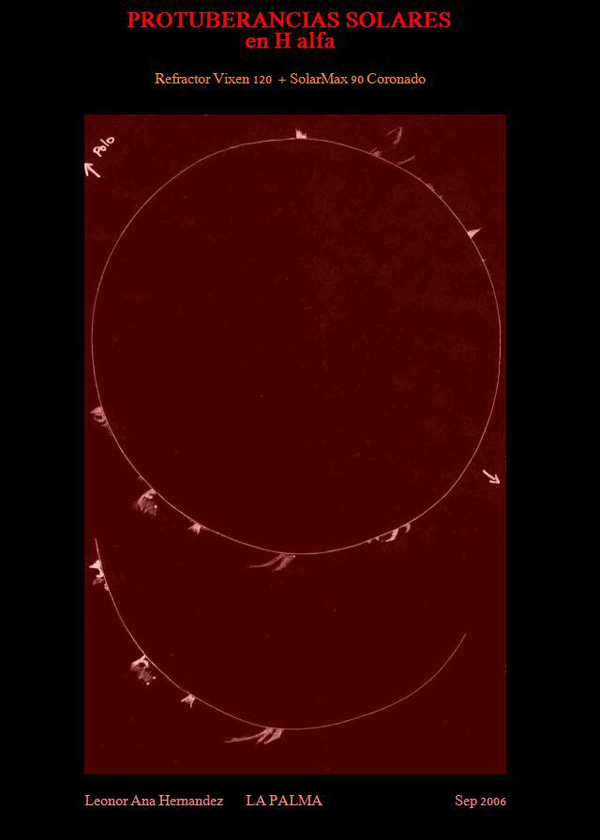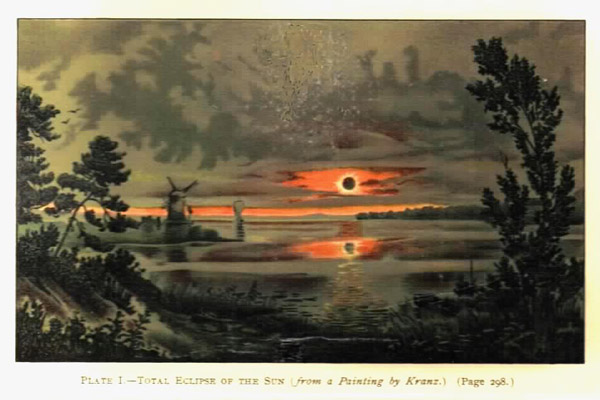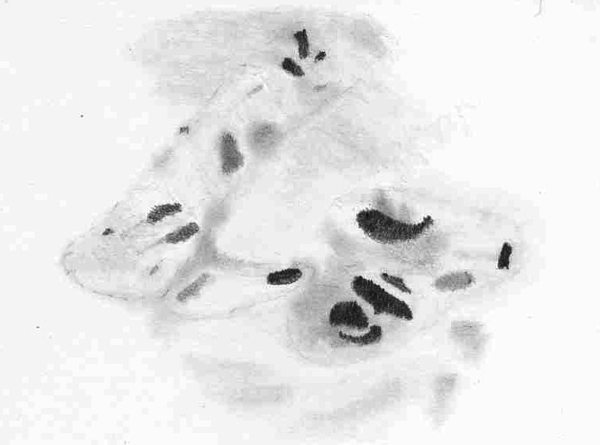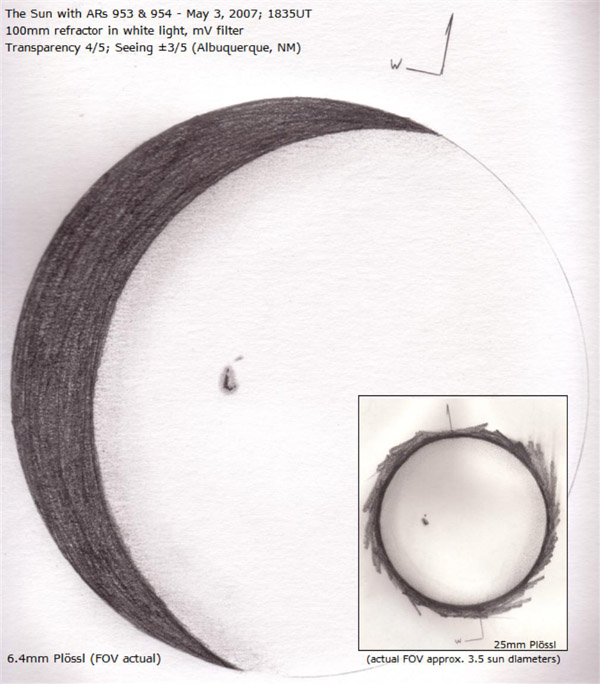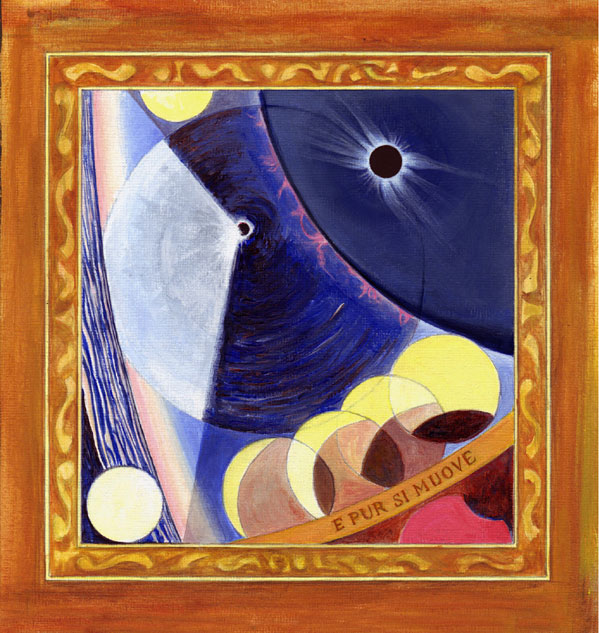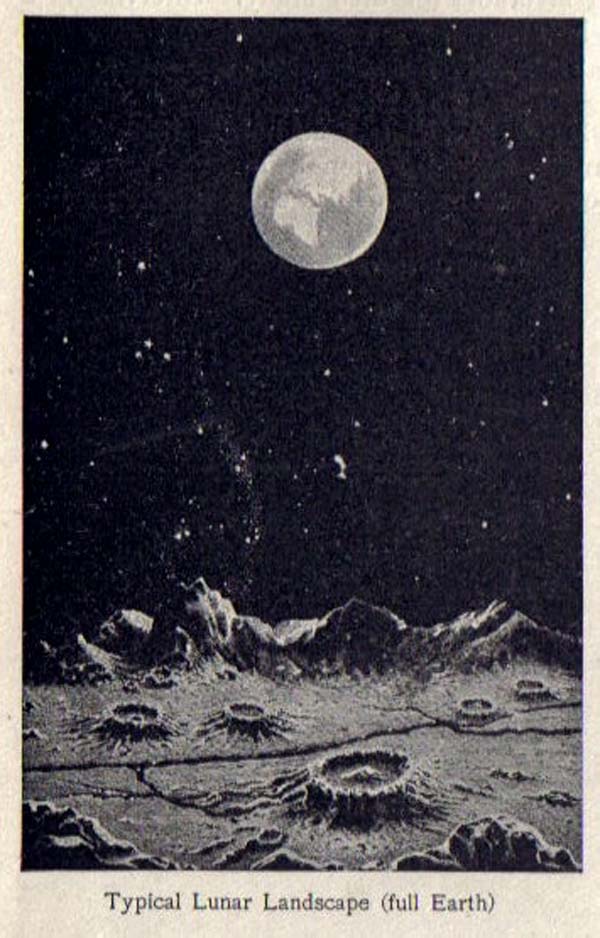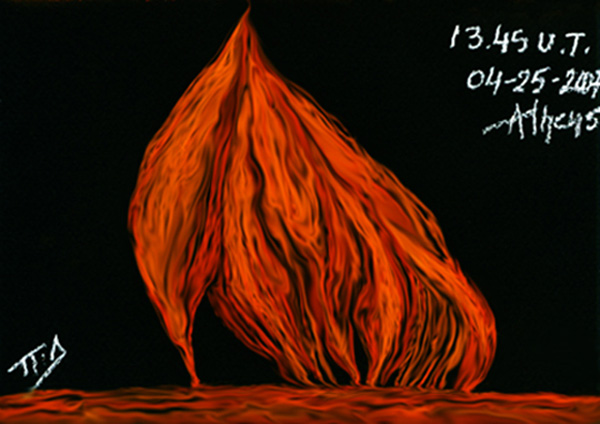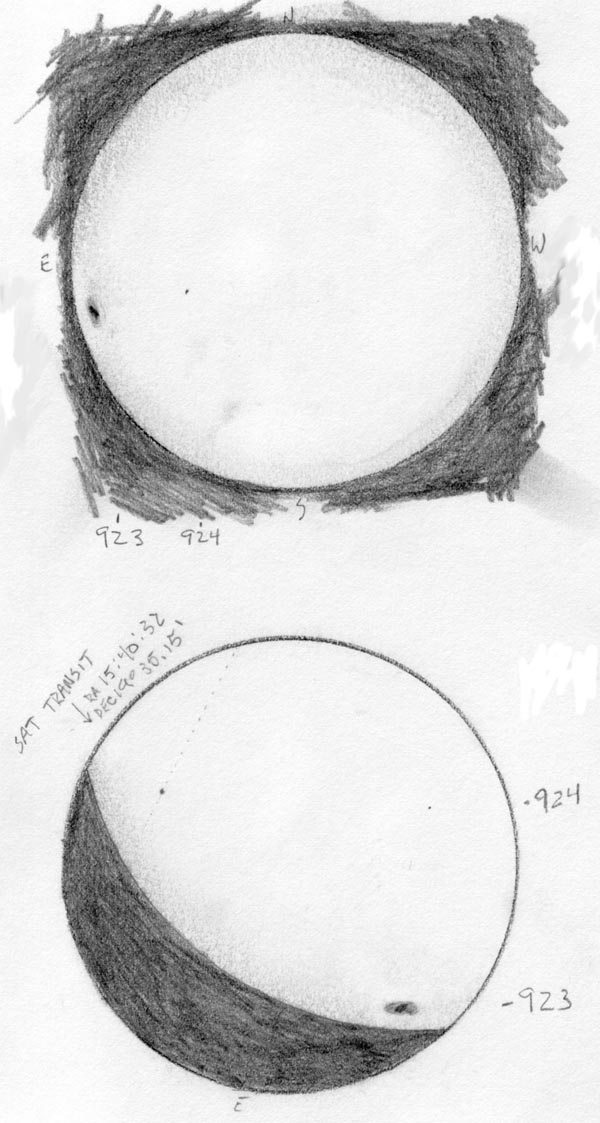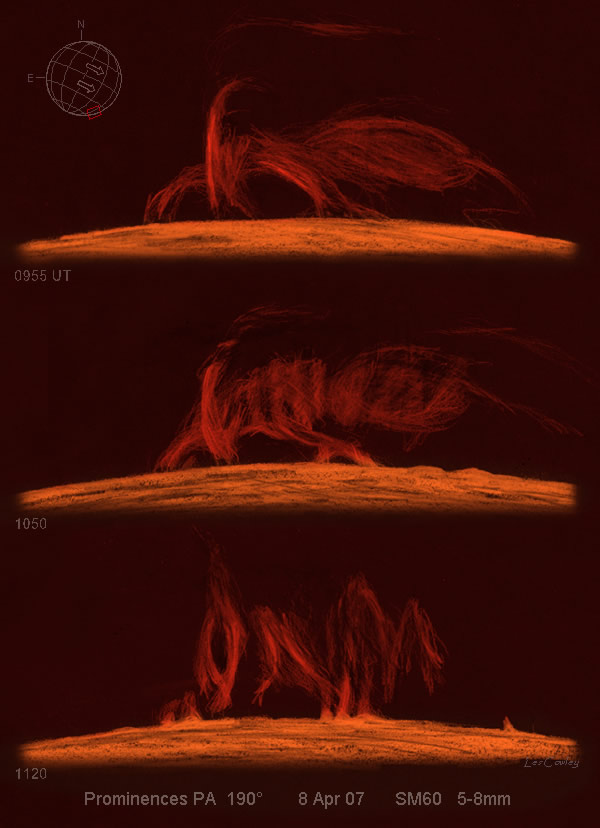This summer I visited a friend in La Palma (Canaries) and could observe the
wonderful sky that there they have with his telescopes. One of them
dedicated to the solar observation is an apochromatic refractor 120 mm.
F/6,5 (Vixen), it has a filter installed H alpha SolarMax 90 (Coronado). The
day I observed he sun was completely clear, the solar limb was full of
protuberances and brilliant lines that following the magnetic fields. I took
immediately graphite pencil and white paper and began to draw everything
what he saw through the filter. I was very surprised because of the rapid
movement of the needles and arches that seems dramatic veils against the
dark sky. I tried to draw the variation of the forms with the passing of the
time but it was difficult. I will never forget that so magic experience.
You can see the place where I spent a week observing in this web site:
www.astropalma.com . When the drawing was finished I changed it to negative
in the computer and turned it a bit red.
Leonor Ana Hernandez
Category: Sun
“Himmel und erde”
Total Solar Eclipse 19th Century
This is a painting in David P. Todd’s, A New Astronomy © 1897, American Book
Company by the 19th century German painter W. Kranz. Unfortunately this beautiful
plate is water damaged top center in my copy of the textbook. The author retrieved
this plate from “Himmel und erde” edited by Dr. Schwahn. Another painting by Kranz
can be found at the LPOD website May 29, 2006. The image on LPOD is a poorly
scanned copy. I have seen a number of Kranz’s drawings and paintings and I tend to
think of him as a19th century forerunner to the great 20th century artist, Chesley
Bonestell.
David P. Todd writes this on pages 297-298 about W. Kranz’s painting in the
frontispiece:
“…Total eclipses occurring near the middle of the year are longest, if at the same
time the moon is near perigee, and their paths fall within the tropics. Always
after total eclipse is over, the partial phase begins again, growing smaller and
smaller and the sun getting continually brighter, until last contact when full
sunlight has returned.… If the atmosphere is saturated with aqueous vapor, weird
color effects ensue, by no means overdrawn in the frontispiece.”
Frank McCabe
Magnetic markers
Living in the UK one has to embrace every opportunity to get the pencils out and
enjoy a little astro sketching as breaks in the cloud cover can be frustratingly
infrequent.
For me this includes capturing Sun spots in white light when the sun shines and
I’m close to my observatory with a few quiet minutes to spare.
I caught the complex Sun Spot group 956 during the afternoon of Saturday 19th May
as it transited the meridian.
Antares 105mm F15 Achromatic refractor
Baader solar film white light filter
Denk binoviewer with Celestron Axiom 23mm eyepieces
Magnification of 163X
Cartridge paper, HB Derwent pencil & blending stump.
Image scanned and mirror flipped.
Dale Holt, Hertfordshire, UK
Sunny side up
The Sun with ARs 953 & 954
After many frustrating weeks of poor conditions, things finally let up long enough
for me to catch a few sketches of the Sun with its (also long-awaited) recent
sunspot activity. These sister ARs are quite impressive, and 953 is the largest I’ve
seen in my short observing career. I can’t wait for Solar Maximum! -æ
(Sketches done in graphite pencil (HB & 3B) on 70# sketch paper.)
Andrew English
Surprises on the Turkish Mediterranian
Eclipse
The total solar eclipse seen from the Turkish Mediterranean coast last year
was our first eclipse. It was an overwhelming and unforgettable experience.
We wanted to soak up the spectacle and so deliberately did not take a
camera, our only equipment was binoculars for a quick look at prominences
and the corona immediately after the start of totality.
All the textbook sights were there, Venus and Mercury before totality, the
pink prominences, a gauzy corona pearly white and twisted and pulled by the
sun’s magnetic fields, diamond rings whiter than diamonds and the receding
lunar shadow blotting out distant mountains. That much was expected. But the
overpowering impressions were the ones that were not expected. The point
like sun and greying light before totality like being in a steel tank lit by
a single light bulb. The rapid and wholly shocking plunge downwards in light
as totality started. The swiftly changing and blazing diamond rings, the
sheer speed of it all. For the first time we got the real sense that we were
on a turning Earth with the Moon and Sun shifting and moving in the heavens.
This little acrylic on board painting tries to sum up those impressions. It
fails miserably – but then what could succeed when pitted against a real
solar eclipse!
Les Cowley
Drawings From an Antique Textbook
Etienne Leopold Trouvelot (12/26/1827- 4/22/1895) was French born (Aisne, France)
Astronomer/Artist that came to the United States of America in 1852 with his family.
After seeing his drawings, the directory of Harvard College Observatory invited
him to join the staff as a member in 1872. During his astronomy years he made
thousands of excellent illustrations and particularly enjoyed drawing the sun.
Sixteen years before his death he returned to France and died in Meudon, France.
In the history of biology and particularly entomology (study of insects) he was
the person know to accidently release a collection of Gypsy moth larvae into the
woods in Medford, Massachusetts. He was attempting by experimental cross breeding
to give disease prone silk moths the disease resistance of Gypsy moths imported
from Europe. Gypsy moths spread westward and northward and remain a pest insect in
North America to this day. A 9 km lunar crater on the south wall of Vallis Alpes is named for him.
The attached solar drawing by Trouvelot is between pages 10 and 11 as Plate II in
David P. Todd’s, A New Astronomy © 1897, American Book Company
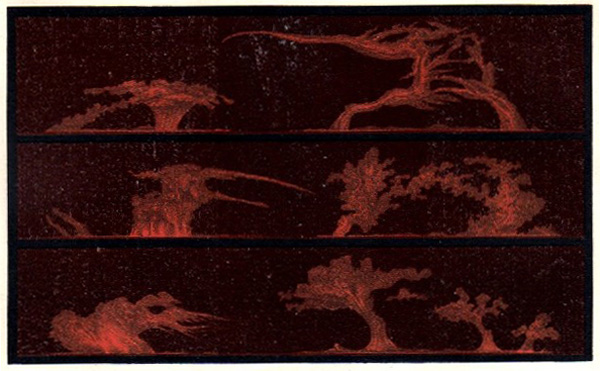
The second drawing by Trouvelot is between pages 282 and 283 as Plate V-Solar
Prominences in David P. Todd’s, A New Astronomy © 1897, American Book Company
As mentioned in the preface on page 4 some of the illustrations have been
re-engraved from the Lehrbuch der Kosmischen Physik of Miller and Peters. A number
of drawings in this text are not credited. One titled a “Typical Lunar Landscape
(full Earth) is the third drawing attached.
Frank McCabe
Stealing the flame from Prometheus
Observed from Athens through my double stacked PST/ SolarMax 40/TMax Filter at
60X (6.7mm U.W).I took this sketch. This large prominence was on the North limb of
the sun on Wednesday 25th April ’07 was great and beautiful.
Sketch was made large on A4 black cartridge paper using colored pastel.
Coloration was enhanced and processed in Photoshop, after leaving the eyepiece.
Peter Desypris
Over a scarlet limb
Easter Parade
A Photoshop rendering of the solar limb as seen with a 70mm refractor (a “Pronto”)
using a 40mm Coronado H-alpha filter and a 12mm Nagler (~40x).
The dynamic chromosphere of our Sun seldom fails to surprise me. A quick setup to
look at the Sun last Sunday (April 8th at local noon) turned into an hour-long
observing session when my telescope revealed a small eruptive prominence.
Unfortunately, the seeing wasn’t as good as it sometimes can be so I patiently
waited for steady moments. Over a hour’s time the “spire” prominence slowly changed
shape with structure — knots — brightening and disappearing. A small hedgerow
prominence (not seen in my drawing) remained virtually unchanged.
This is my first attempt at running one of my rough pencil sketches through
Photoshop. I hope, with time and practice — and better seeing — I can improve
my drawings.
Dave Riddle
A satellite runs through it
The Sun with AR923 & 924
The Sun in white light with active regions 923 & 924: November 19, 2006
100mm achromat refractor with 10mm Plössl e/p & MV filter for contrast.
From Albuquerque, NM (36N 106W).
(2nd frame: mysterious satellite transit at 2132UT; RA 15:40:32, Dec. 19° 35.15′)
Sketch medium: graphite on paper.
Andy English
Solar creatures?
We sometimes imagine that clouds take on the shape of creatures. These
prominences on the south limb of the sun on Sunday 8th April ’07 have been
similarly likened to a firebird, an ostrich, a wasp and a feeding spider.
When actually trying to sketch prominences it is better not to imagine such
things or else the drawings will tend to drift irresistibly towards the
imagined beasts!
These prominences were in any case very difficult to render. They were
changing literally from minute to minute and were also ‘upside down’ in the
eyepiece. The changes were so great that I started to wonder whether I had
got their structure at all correct but later comparison with images taken at
about the same time were reassuring.
Observed from England through a single stacked SolarMax60 H-alpha ‘scope at
50-80X. There were varying amounts of high altitude cirrus haze but some
moments of high contrast clarity and atmospheric steadiness. Sketches were
made large on A4 Canford black cartridge paper using white Derwent Studio
and Derwent Watercolour pencils, the latter dry. Coloration was done in
Photoshop, this was the only modification made to the sketches after leaving
the eyepiece.
Les Cowley

